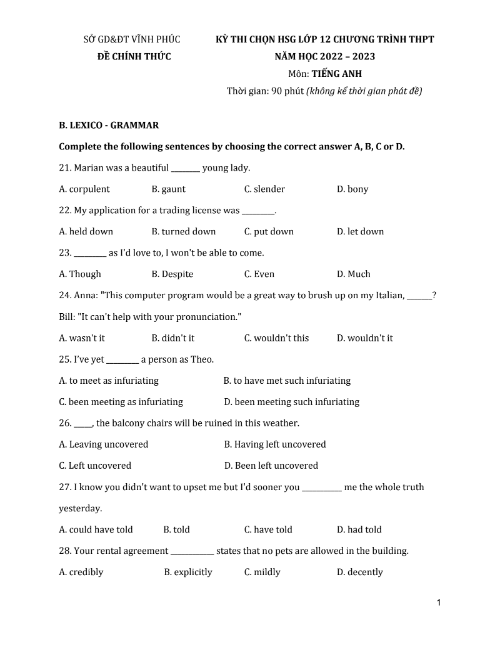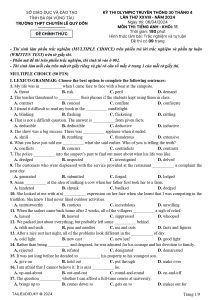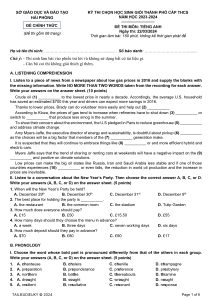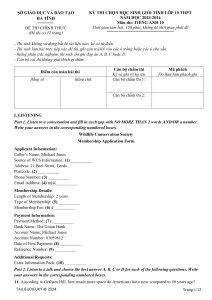Đề thi Chọn HSG lớp 12 Chương trình THPT, tỉnh Vĩnh Phúc năm học 2022-2023 môn Tiếng Anh là tài liệu quan trọng dành cho các thí sinh muốn ôn tập và chuẩn bị cho kỳ thi chọn HSG cấp tỉnh. Tài liệu này có sẵn dưới dạng file PDF và Word tại website Tài liệu diệu kỳ, nơi chia sẻ kiến thức và tài liệu tiếng Anh đa dạng.
Đề thi gồm 4 phần chính: A. Listening, B. Lexico and Grammar, C. Reading comprehension, D. Writing. Đặc biệt, tài liệu còn đi kèm Hướng dẫn chấm (đáp án) chính thức của Sở GD&ĐT tỉnh Vĩnh Phúc. Thời gian làm bài là 90 phút, không tính thời gian phát đề. Đề thi có 10 trang và bao gồm các dạng bài tập như Word formation, Multiple-choice questions, Guided cloze, Open Cloze, cùng phần Writing với Sentence transformations và Key word transformation. Phần Writing đặt ra thách thức cho thí sinh về hiểu biết về collocations và thành ngữ nâng cao trong Tiếng Anh.
Đề thi này dành cho các thí sinh thuộc hệ THPT (không theo học hệ Chuyên tại trường THPT Chuyên Vĩnh Phúc). Đặc biệt, đề thi có mức độ phân hóa rõ ràng, giúp chọn ra những thí sinh có năng lực Tiếng Anh toàn diện nhất. Đề thi có định dạng (cấu trúc) quen thuộc, giúp thí sinh có thể dễ dàng tìm tài liệu ôn tập và chuẩn bị kĩ càng hơn khi đối mặt với kỳ thi chọn HSG cấp tỉnh lớp 12 tỉnh Vĩnh Phúc năm học sắp tới.
Ngoài ra, website Tài liệu diệu kỳ cũng cung cấp nhiều tài liệu liên quan khác mà bạn có thể tham khảo thêm để nâng cao kỹ năng Tiếng Anh. Để tải xuống đề thi và các tài liệu khác, bạn có thể truy cập website và tìm kiếm theo yêu cầu của mình. Hãy sử dụng tài liệu này để ôn tập và chuẩn bị tốt nhất cho kỳ thi chọn HSG cấp tỉnh lớp 12 năm học sắp tới. Chúc bạn thành công trong hành trình học tập và nâng cao kỹ năng Tiếng Anh của mình!
Trích dẫn nội dung "ĐỀ THI CHỌN HSG LỚP 12 CHƯƠNG TRÌNH THPT, TỈNH VĨNH PHÚC NĂM HỌC 2022 – 2023 Môn TIẾNG ANH có đáp án":
SỞ GD&ĐT VĨNH PHÚC ĐỀ CHÍNH THỨC
B. LEXICO - GRAMMAR
KỲ THI CHỌN HSG LỚP 12 CHƯƠNG TRÌNH THPT NĂM HỌC 2022 – 2023
Môn: TIẾNG ANH
Thời gian: 90 phút (không kể thời gian phát đề)
Complete the following sentences by choosing the correct answer A, B, C or D. 21. Marian was a beautiful ________ young lady.
A. corpulent B. gaunt C. slender D. bony 22. My application for a trading license was _________.
A. held down B. turned down C. put down D. let down 23. _________ as I'd love to, I won't be able to come.
A. Though B. Despite C. Even D. Much 24. Anna: "This computer program would be a great way to brush up on my Italian, _______? Bill: "It can't help with your pronunciation."
A. wasn't it B. didn't it C. wouldn't this D. wouldn't it 25. I’ve yet _________ a person as Theo.
A. to meet as infuriating B. to have met such infuriating C. been meeting as infuriating D. been meeting such infuriating 26. _____, the balcony chairs will be ruined in this weather.
A. Leaving uncovered B. Having left uncovered
C. Left uncovered D. Been left uncovered
27. I know you didn't want to upset me but I'd sooner you ___________ me the whole truth yesterday.
A. could have told B. told C. have told D. had told 28. Your rental agreement ____________ states that no pets are allowed in the building. A. credibly B. explicitly C. mildly D. decently
1
29. Children can be difficult to teach because of their short attention ________. A. limit B. duration C. span D. time 30. You are too old to carry on working. It's time you called it a _____________. A. year B. month C. week D. day
31. Helen was ____________ disappointed when she learnt that she hadn't won the beauty contest.
A. seriously B. bitterly C. strongly D. heavily 32. Wasn't it you yourself _____________ the door open?
A. to leave B. to have left C. that should leave D. who left 33. If the driver _______ his seat belt, he might be alive today.
A. was wearing B. had been wearing C. wear D. wore
34. The speech attacked American policy in _______ was later considered to be part of a campaign to undermine the government.
A. which B. where C. that D. what
35. Going to the unemployment office and having to wait there for hours is a ____________ experience.
A. soul-destroying B. heart-stopping
C. thought-provoking D. power-sharing
C. READING COMPREHENSION
Section 1. Choose the correct answer to complete the following passage.
United Parcel Service (UPS) believes that its employees should give the firm a fair day's work for a fair day's pay. The package delivery firm seems willing to give more than a fair day's pay. But in (36) _________, UPS expects maximum output from its employees. Since 1920s, the firm's industrial engineers have been studying every detail of every task (37) _______ by most UPS employees. From their studies have come time and motion standards that (38) ______ how those tasks are performed and how long they should take. Drivers, for example, are expected to walk to a customer's door at a speed of exactly three feet per
2
second. They are told to knock as soon as they get there, rather than waste time (39) ________ a doorbell. Work engineers are (40) ______ riding with drivers, timing everything from stops at traffic lights, wait at customers' doorway, stairway climbs, to coffee break. And they are not (41) _______ to pointing out the occasional inefficiency. Additionally, supervisors ride with the least good drivers, noting how they work and constantly (42) ___________ them until their work is up to standard. The (43) __________ of all this engineering work is efficiency, and UPS has been called one of the most efficient companies anywhere. It's also a highly profitable company. Most drivers take the regimentation in stride: many show (44) ______ in meeting the UPS standards each day. Others, however, feel that they are constantly being pushed, and that it is impossible for them to (45) ________ at work. UPS officials claim that the standards provide accountability. And, they say, employees who work according to UPS standards should feel less tired at the end of the day.
36. A. fact B. exchange C. return D. short 37. A. hold B. performed C. accepted D. made 38. A. indicate B. govern C. demonstrate D. tell 39. A. looking at B. look at C. look for D. looking for 40. A. consistently B. continually C. constructively D. chronically 41. A. impolite B. brave C. intimate D. averse 42. A. scolding B. criticizing C. encouraging D. correcting 43. A. task B. reason C. object D. job 44. A. pride B. passion C. interest D. pleasure 45. A. rest B. relieve C. relax D. restrain
Section 2. Fill in the gap with ONE suitable word.
There have always (46) __________ famous sportsmen and women, but until quite recently nobody made a lot of money from playing sports. It was a hobby, not a professional career. But it's quite different today. Professional sports can now be extremely lucrative and top players earn salaries that sports stars a few years ago could only (47) _________ about. Today sport is a ticket to fame and fortune.
3
The transformation of sport from a (48) ______ activity to an industry has occurred (49) ______ of the increasing importance of television in our lives. Sport and television are the perfect fit. Television provides enormous audiences and sport provides spectacular drama, (50) _______ joy, despair, excitement and tension in equal measure. What's more, television offers viewers all this drama in the comfort of their own homes. It's a winning combination.
Of course, advertisers have been quick to see the true potential of this partnership. Sponsorship is popular, (51) ___________ football players who have the names of their sponsors on their kit to the Formula. One (52) ________ whose cars are covered in the names of the companies which finance them. There are teams, stadiums, and even competitions named (53) __________ the companies which have invested money in them. And all these major sporting events are shown on television at (54) ______ which will reach a maximum audience. Sports events have become very long TV (55) ___________.
Section 3. Read the following passage and mark the letter A, B, C or D on your answer sheet to indicate the correct answer to each of the questions.
In the course of its history, human inventions have dramatically increased the average amount of energy available for use per person. Primitive peoples in cold regions burned wood and animal dung to heat their caves, cook food, and drive off animals by fire. The first step toward the developing of more efficient fuels was taken when people discovered that they could use vegetable oils and animal fats in lieu of gathered or cut wood. Charcoal gave off a more intensive heat than wood and was more easily obtainable than organic fats. The Greeks first began to use coal for metal smelting in the 4th century, but it did not come into extensive use until the Industrial Revolution.
In the 1700s, at the beginning of the Industrial Revolution, most energy used in the United States and other nations undergoing industrialization was obtained from perpetual and renewable sources, such as wood, water streams, domesticated animal labor, and wind. These were predominantly locally available supplies. By mid-1800s, 91 percent of all commercial energy consumed in the United States and European countries was obtained from wood. However, at the beginning of the 20th century, coal became a major energy source and replaced wood in industrializing countries. Although in most regions and
4
climate zones wood was more readily accessible than coal, the latter represents a more concentrated source of energy. In 1910, natural gas and oil firmly replaced coal as the main source of fuel because they are lighter and, therefore, cheaper to transport. They burned more cleanly than coal and polluted less. Unlike coal, oil could be refined to manufacture liquid fuels for vehicles; a very important consideration in the early 1900s, when the automobile arrived on the scene.
By 1984, nonrenewable fossil fuels, such as oil, coal, and natural gas, provided over 82 percent of the commercial and industrial energy used in the world. Small amounts of energy were derived from nuclear fission, and the remaining 16 percent came from burning direct perpetual and renewable fuels, such as biomass. Between 1700 and 1986, a large number of countries shifted from the use of energy from local sources to a centralized generation of hydropower and solar energy converted to electricity. The energy derived from nonrenewable fossil fuels has been increasingly produced in one location and transported to another, as is the case with most automobile fuels. In countries with private, rather than public transportation, the age of nonrenewable fuels has created a dependency on a finite resource that will have to be replaced.
Alternative fuel sources are numerous, and shale oil and hydrocarbons are just two examples. The extraction of shale oil from large deposits in Asian and European regions has proven to be labor consuming and costly. The resulting product is sulfur- and nitrogen-rich, and large-scale extractions are presently prohibitive. Similarly, the extraction of hydrocarbons from tar sands in Alberta and Utah is complex.
Semi-solid hydrocarbons cannot be easily separated from the sandstone and limestone that carry them, and modern technology is not sufficiently versatile for a large scale removal of the material. However, both sources of fuel may eventually be needed as petroleum prices continue to rise and limitations in fossil fuel availability make alternative deposits more attractive.
56. What is the main topic of the passage?
A. Applications of various fuels
B. Natural resources and fossil fuels
C. A history of energy use
5
D. A historical overview of energy rates
57. The phrase per person in paragraph 1 is closest in meaning to
A. per capita B. per year C. per family D. per day 58. It can be inferred from the first paragraph that _________________.
A. coal mining was essential for primitive peoples
B. the Greeks used coal in industrial production
C. the development of efficient fuels was a gradual process
D. the discovery of efficient fuels was mostly accidental
59. The phrase in lieu in paragraph 1 is closest in meaning to ______________. A. in spite B. in place C. in every way D. in charge 60. The author of the passage implies that in the 1700s, sources of energy were _____________. A. used for commercial purposes
B. used in various combinations
C. not derived from mineral deposits
D. not always easy to locate
61. The phrase the latter in paragraph 2 refers to _____________.
A. wood B. coal C. most regions D. climate zones 62. According to the passage, what was the greatest advantage of oil as fuel? A. It was a concentrated source of energy.
B. It was lighter and cheaper than coal.
C. It replaced wood and coal and reduced pollution.
D. It could be converted to automobile fuel.
63. It can be inferred from the passage that in the early 20th century, energy was obtained primarily from _______________.
A. fossil fuels B. nuclear fission
C. burning biomass D. hydraulic and solar sources
6
64. Which of the following is NOT a characteristic of alternative fuel sources? A. cheap B. labour-consumin C. prospective D. numerous 65. The word prohibitive in paragraph 4 is closest in meaning to __________. A. prohibited B. provided C. too expensive D. too expedient
D. WRITING
Section 1. Rewrite each of the following sentences in such a way that it has a similar meaning to the original one.
66. In the unlikely event of a fire, please do not use the lift.
→Should there ____________________________________.
67. It's impossible for them to have found him in that jungle.
→ He can't _______________________________________.
68. Customs officials are stopping more travellers than usual this week. → An increased ____________________________________________.
69. The policeman acted quickly and averted an accident.
→The prompt __________________________________.
70. What a surprise to see you here.
🡪 Fancy _______________________________________.
Section 2. Use the word in capitals to rewrite each of the following sentences in such a way that it has a similar meaning to the original one. The words given MUST NOT be altered in any way.
71. Danny was asked to leave school for bad behavior. EXPELLED
🡪 Danny ________________________________________________.
72. Would you give us your answer as soon as possible. CONVENIENCE → Please respond _____________________________________________.
73. I passed the exam, but only just! SCRAPE
7
→ I managed _________________________________________________.
74. He thinks his friends do not appreciate him. GRANTED
→He dislikes __________________________________________________.
75. A friend of ours fixed the car for us. FRIENDS
→ We had _____________________________________________________.
-------------------- THE END ---------------------
8
SỞ GD&ĐT VĨNH PHÚC HƯỚNG DẪN CHẤM
B. LEXICO-GRAMMAR
KỲ THI CHỌN HSG LỚP 12 CHƯƠNG TRÌNH THPT NĂM HỌC 2022-2023
Môn: TIẾNG ANH
21.C
22.B
23.D
24.D
25.A
26.C
27.D
28.B
29.C
30.D
31.B
32.D
33.B
34.D
35.A
C. READING
Section 1.
36.C
37.B
38.
39.D
40.B
41.D
42.D
43.C
44.A
45.C
Section 2.
46. been
47. dream
48. leisure/
recreational
49. because
50. including
51. from
52. racers/
teams
53. after
54. hours
55. shows/
programmers
Section 3.
56.C
57.A
58.B
59.B
60.C
61.C
62.D
63.A
64.A
65.C
D. WRITING
Section 1.
66. Should there be a fire, please do not use the lift.
67. He can't have been found in that jungle.
9
68. An increased number/quantity of travellers are being stopped by customs officials this week.
69. The prompt action of the policeman averted an accident.
70. Fancy seeing you here.
Section 2.
71. Danny was expelled from school for bad behavio(u)r.
72. Please respond at your earliest convenience.
73. I managed to scrape through the exam.
74. He dislikes being taken for granted by his friends/his friends taking him for granted.
75. We had one of our friends fix the car (for us)/the car fixed (for us) by one of our friends.
------------- THE END ----------------
10



